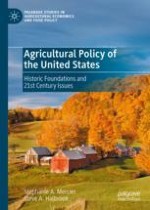This book serves as a foundational reference of U.S. land settlement and early agricultural policy, a comprehensive journey through the evolution of 20th century agricultural policy, and a detailed guide to the key agricultural policy issues of the early 21st century. This book integrates the legal, economic and political concepts and ideas that guided U.S. agricultural policy from colonial settlement to the 21st century, and it applies those concepts to the policy issues agriculture will face over the next generation.
The book is organized into three sections. Section one introduces the main themes of the book, explores the pre-Columbian period and early European settlement, and traces the first 150 years of U.S. agricultural policy starting with the post revolution period and ending with the “golden age” of agriculture in the early 20th century. Section two outlines that grand bargain of the 1930s that initiated the modern era of government intervention into agricultural markets and traces this policy evolution to the early days of the 21st century. The third section provides an in-depth examination of six policy issues that dominate current policy discussions and will impact policy decisions for the next generation: trade, environment/conservation, commodity checkoff programs, crop insurance, biofuels, and domestic nutrition programs.
